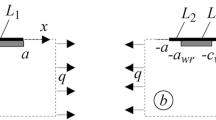Abstract
A plate with a semi-infinite crack is repaired by having reinforcing sheets bonded to its faces, and is subjected to a uniformly distributed tensile load at right-angles to the crack. It is shown that the crack extension force has a finite value, provided that the reinforced structure can still carry the load if the crack, instead of being semi-infinite, runs across the whole plate, cutting it in half. The case of a plate with a crack of finite length is considered next: the determination of the force is reduced to the solution of a Fredholm integral equation, from which the asymptotic behaviour for short cracks is deduced by the method of successive approximations. These results provide an upper bound to the force for arbitrary crack lengths. A comparison with numerical results suggests that this upper bound is sufficiently close to the actual value to be useful in practice. The residual thermal stress induced by the process of bonding, and the resulting force on a crack, are shown to depend sensitively on the nature of the constraint at the edges of the plate, as well as on the extent of the plate outside the heated region. A number of extensions to less idealized configurations are discussed.
Résumé
On a procédé à une réparation d'une plaque présentant une fissure semi-infinie en fixant des tôles de renforcement sur chacune de ses faces et on a soumis cette plaque à une contrainte de traction uniformément distribuée à angle droit de la fissure. On montre que la force d'extension de la fissure a une valeur finie, pour autant que la structure de renforcement puisse encore supporter la charge si la fissure au lieu d'être semi-infinie se développe à travers toute la plaque et la coupe ainsi en deux. On considère ensuite le cas d'une plaque possédant une fissure de longueur finie: la détermination de la force se réduit à la solution d'une équation intégrale de Fredholm à partir de laquelle on peut déduire le comportement asymptotique dans le cas de fissure courte par une méthode d'approximations successives. Ces résultats fournissent une limite supérieure à la force nécessaire pour étendre des fissures de longueurs arbitraires. Une comparaison avec des résultats numériques suggèrent que cette limite supérieure est suffisamment proche de la valeur actuellement utilisable en pratique. On montre que les contraintes thermiques résiduelles qui sont induites par le processus de collage et que les forces qui en résultent sur la fissure, dépendent de manière sensible de la nature des contraintes au bord de la plaque ainsi que du développement de la plaque en dehors de la région chauffée. On discute un certain nombre d'extensions à des configurations moins idéales.
Similar content being viewed by others
References
A.A. Baker, Composites 9 (1978) 1–16.
A.A. Baker, G.A. Hawkes and E.J. Lumley, in Proceedings of the Second International Conference on Composite Materials, B. Noton et al. (eds.), AIME (1978).
A.A. Baker, M.J. Davis and G.A. Hawkes, in Proceedings of the Tenth Symposium of the International Committee on Aeronautical Fatigue, Brussels (1979). (This work has a limited distribution. Copies may be obtained from Dr. Baker, A.R.L., Box 4331 G.P.O., Melbourne 3001, Australia).
J.P. Hirth and J. Lothe, Theory of Dislocations, McGraw-Hill, N.Y. (1968) 64.
L.M. Keer, C.T. Lin and T. Mura, Journal of Applied Mechanics 43 (1976) 652–656.
M.M. Ratwani, Journal of Engineering Materials and Technology 100 (1978) 46–51.
M.M. Ratwani, AIAA Journal 17 (1979) 988–994.
L.J. Hart-Smith, Analysis and Design of Advanced Composite Bonded Joints, NASA Contractor Report CR-2218 (1974).
I.N. Sneddon and M. Lowengrub, Crack Problems in the Classical Theory of Elasticity, Wiley, N.Y. (1969).
G.R. Irwin, Journal of Applied Mechanics 24 (1957) 361–364.
M.J. Lighthill, Fourier Analysis and Generalized Functions, Chap. 4, Cambridge University Press (1958).
J.P. Benthem and W.T. Koiter, in Methods of Analysis and Solutions of Crack Problems, G.C. Sih (ed.), Noordhoff, Leyden (1973).
A.B.J. Clark and G.R. Irwin, Experimental Mechanics 6 (1966) 321–330.
R. Jones and R.J. Callinan, Journal of Structural Mechanics 8 (1980) 143–149.
C.C. Poe, in Damage Tolerance in Aircraft Structures, Special Technical Publication 486, ASTM, Philadelphia (1971).
Author information
Authors and Affiliations
Rights and permissions
About this article
Cite this article
Rose, L.R.F. A cracked plate repaired by bonded reinforcements. Int J Fract 18, 135–144 (1982). https://doi.org/10.1007/BF00019638
Received:
Issue Date:
DOI: https://doi.org/10.1007/BF00019638




